

Catch Fish with
Mike Ladle
Information Page
SEA FISHING
For anyone unfamiliar with the site always check the FRESHWATER, SALTWATER and TACK-TICS pages. The Saltwater page now extends back as a record of over several years of (mostly) sea fishing and may be a useful guide as to when to fish. The Freshwater stuff is also up to date now. I keep adding to both. These pages are effectively my diary and the latest will usually be about fishing in the previous day or two. As you see I also add the odd piece from my friends and correspondents if I've not been doing much. The Tactics pages which are chiefly 'how I do it' plus a bit of science are also updated regularly and (I think) worth a read (the earlier ones are mostly tackle and 'how to do it' stuff).
Different bites and a plague of congers.
It's been an odd week of fishing. I've had a couple of trips to the coast; firstly an evening session with freelined baits and the second was to do a spot of lure fishing. Recently my pal Martyn had tried bait fishing from the shore and he caught no bass but he had a decent pollack - fairly unusual in the spot he was trying. This year we've not done very well with baits for bass and I was curious about the other non-bass bites we get, which generally result in nothing being hooked. Usually the bass pick up the bait and tear away at high speed for some distance before being hooked or missed. I asked him about the nature of the pollack bite on the big, free-lined baits. He said that the fish took his mackerel fillet, gave a fairly strong run for a few metres and was then neatly hooked in the jaw when he tightened. The other bites we've had were either the rasping vibrations which I'm sure are mullet sucking at the bait or tugging irregular pulls which, when hooked have turned out to be small conger eels (more about them in a minute).
Anyway, to return to my own fishing, I decided to fish the spot where my pal had at least caught something. I baited the 8/0 circle hook with the front half of a large pilchard hooked through the jaws and cast it out ten metres or so. It was probably ten or fifteen minutes before I had a bite then there was a pull which I was instantly sure was a fish. The line began to run out and I was thinking 'a bass at last' but it didn't feel quite right - not strong enough, nor fast enough, nor long enough to be a big bass. It stopped taking line so I thought it had gone then it began to move again. I closed the bale and let the line tighten - it was on! The fish was pulling reasonably well but not taking any line so at first I wondered if it was a small bass but it was less fast and splashy and eventually when I switched on the headlamp and slid it ashore I could see that it was a reasonable pollack, similar to the one Martyn had caught on his trip. I took a picture and slipped the fish back into the sea before baiting up with the back half of my pilchard and casting out again. After a bit of a wait I had another bite but this one was a fiddly tugging and pulling version. Eventually I decided to reel in and discovered that I'd hooked a small eel - sure enough it was a baby conger and this one had swallowed the huge hook.
My pals who have tried bait fishing this year have all reported catching small congers so I asked around and found that these fish seem to be everywhere. In years gone by we used to catch lots of big congers on conventional beach casting gear and they probably averaged fifteen pounds or more but more recently this has not been the case. However, it seems that the small ones are currently everywhere. In fact this year they have become a nuisance when we are free-lining for bass. As far as I am aware male congers don't get much bigger than two to two-and-a-half feet in length; so all the big fish are females. The smaller fish that we are catching probably only arrived at our shores within the past year as the larvae don't become 'eel like' and colour up properly until they are over a foot in length. I suppose it is possible that the fish being caught at the moment are all males but perhaps it is more likely that they are young fish from a very successful spawning (in the deep waters of the Atlantic) during recent years. The female fish, it seems, grow quickly and there is a report of a conger placed in an aquarium at about 2-3lb attaining a weight of over 20lb in about two years and another getting to 90lb in 5.5 years. Whether they are able to do this in the wild is debatable. Anyway, perhaps we are in for a few good conger seasons soon?
Oh, I'd almost forgotten the lure fishing trip. The bass that my pals were been catching in the recent rough conditions all took lures; mostly soft plastics. In the space of a couple of days we have landed about thirty fish in two or three short sessions. Most of the fish caught were the usual two pounders with the odd one a bit bigger. Good fun but not spectacular.
A nice pollack in mint condition.
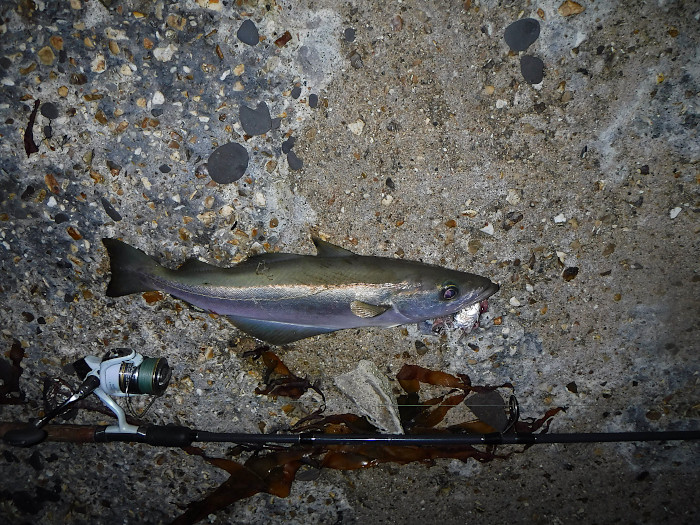
Typical tiny conger.
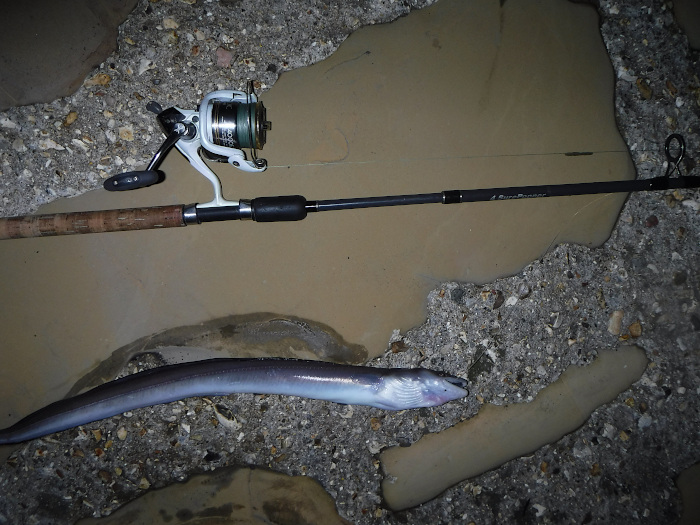
This one had swallowed the hook.
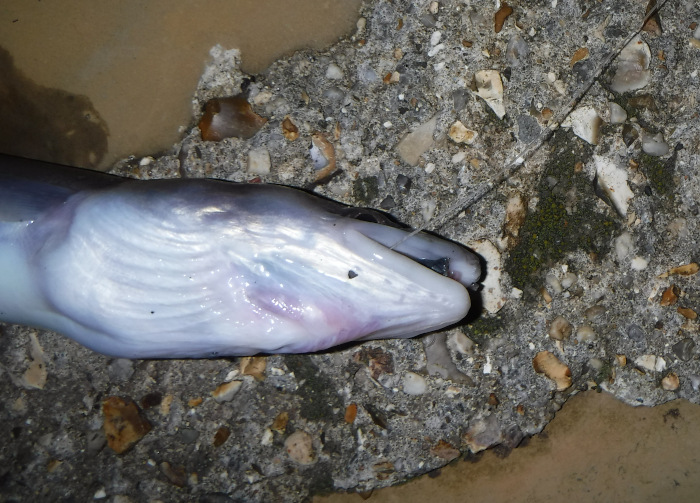
A small bass on my Slandra.
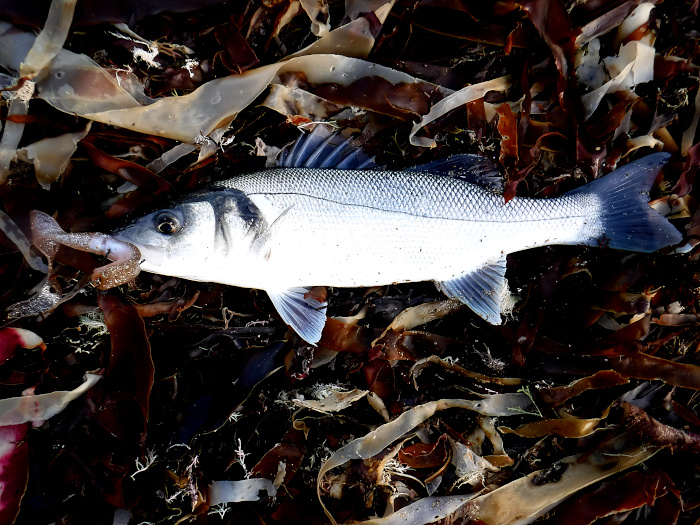
Nicely hooked on the Texposer hook.
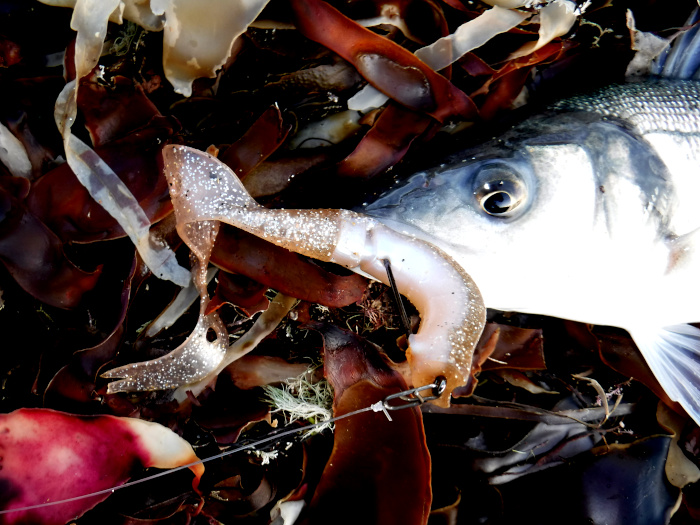
– PLEASE TELL YOUR TWITTER, FACEBOOK, EMAIL FRIENDS ABOUT THESE BOOKS.
NEW BOOK
"Fishing for Ghosts - Successful Mullet Angling"
written with David Rigden IT'S AVAILABLE FROM -ALSO THE NEW BOOK
“The Second Wave”
Written with Steve Pitts this is a SEQUEL TO THE BESTSELLER "Operation Sea Angler" IT'S AVAILABLE ON PAPER OR FOR YOUR KINDLE FROM -If you have any comments or questions about fish, methods, tactics or 'what have you!' get in touch with me by sending an E-MAIL to - docladle@hotmail.com